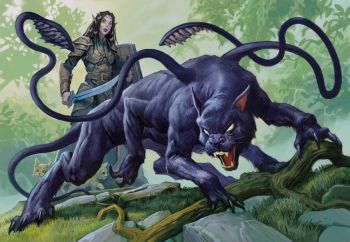Displacer Beast
| Species | beast |
| No. Appearing | 2–5 |
| Behaviour | social (pride) |
| Range | alpine, steppe, tundra, veldt |
| Size | 11 ft. long |
| Weight | 440 lbs. |
| Intelligence | 4 |
| Armour Class | 2 |
| Hit Dice | 6 |
| Action Points | 7 |
| Max. Stride | 13 |
| THAC0 | 17 |
| Hp/Die | 2d4 |
| Attack Forms | 5: two claws; two tentacles, fangs |
| Damage | claw (2-8); tentacle (1–10); fangs (2-12) |
| Special Attacks | heightened smell, phase, raking, tentacles |
Displacer beasts are formidable, cougar-like monsters that prefer expansive, treeless country covered by dense grasses or the sheltered expanse of ancient Precambrian shield-lands. They thrive in lands ranging from temperate to arctic climates, as their metabolism allows them to adapt to harsh environmental conditions. Surpassing a cougar in size, they boast a weight equivalent to that of a lion. Some variants boast six legs, like the one shown; others have only four legs.
Contents
The tentacles are flexible and sinuous, sprouting from their shoulders. Some species possess four rather than two. These appendages are agile and equipped with sharp, barbed tips that the beast uses to strike at prey or fend off threats. Strikes are both quick and accurate, allowing the creature to incapacitate or kill its prey efficiently.
Behaviour
Though the beast will appear in tightly knit groups, hunting together, they are not familial. The origin of displacer beasts is unknown; every example of the beast that has been examined has proven to be male. The manner in which more displacer beasts come to be, something that must be so because their number has never been observed to diminish, has been an enduring mystery.
More intelligent than a typical feline, a group of displacer beasts make very dangerous hunters. They will prefer to stalk a party in the wild for days, typically allowing their prey to move miles ahead in the daytime while tracking them steadily and catching up again at night. The displacer beast will use its black coloring and other abilities (see below) to move close enough to strike for one round with its tentacles before returning to the dark, where it may wait hours before moving in again, sensing when its prey has relaxed through a keen sense of smell. Several displacer beasts will attack one after another, each choosing to risk an attack when it feels most likely to cause damage and then escape safely.
Advantages
The tentacles emerging from its back are covered with bone-spikes, which the beast is able to snap at opponents, delivering a blow that is comparable to being hit with a massive mace. These tentacles can hit at a range up to two hexes (10 ft.) At the same time, the creature can attack with its claws and its bite. It will usually attack a single target with its claws and bite, then up to one or two other targets with its tentacles. If it hits with both its front claws in a single round, the beast will rake with its back claws for 2–8 damage each.
The creature's strangest abnormality is not its tentacles, but the strange way that it will phase one hex at the end of each round. This is an involuntary occurrence, over which the beast has no control; the displacement will never be ahead or behind the beast's former position, but always within a 120° arc to the left or the right, with a random die rolled for each. Because of this peculiar advantage, missile weapons that are hurled at the beast at night, when the beast's inky black outline is indistinct, will always miss if the creature is four or more hexes away (20 feet). The combatant must be able to see the creature clearly in order to compensate for the phase (which the spell ultravision can provide but which infravision cannot, because the creature leaves behind a heat blur as it phases). The phase has no special effect upon the beast's armour class.
See Bestiary
